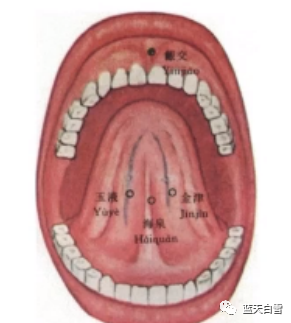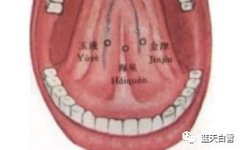Jin Jin and Yu Ye are names for the external extraordinary points.Also known as Lian Quan, they are located under the tongue.According to the “Great Compendium of Acupuncture and Moxibustion,” they are situated on both sides of the tongue, precisely at the lateral edges, with Jin Jin on the left and Yu Ye on the right.

According to the “Illustrated Compendium of Acupuncture,” Jin Jin is on the left and Yu Ye on the right, located on the purple collaterals under the tongue.They are primarily used to treat conditions such as diabetes, oral ulcers, tongue swelling, and throat obstruction.Using a three-edged needle can induce bleeding.
According to the “Elementary Text of Medical Classics,” the method for locating these points involves: … There are two points on the purple collaterals at the base of the tongue, with Jin Jin on the left and Yu Ye on the right.
As stated in the “Great Compendium of Acupuncture and Moxibustion,” these points are located on the purple collaterals on both sides of the tongue, and can be accessed by rolling the tongue. They are used to treat severe tongue swelling, throat pain, and can induce bleeding using a three-edged needle boiled in water.
Jin Jin and Yu Ye refer to the sublingual collaterals, specificallythe two relatively thick bluish-purple collaterals under the tongue.
Normal sublingual collaterals:Generally, their width does not exceed 2.7mm, and their length does not exceed three-fifths of the distance from the tip of the tongue to the sublingual tubercle.
1. The sublingual collaterals are closely connected to the five zang organs.
The “sublingual collaterals” are distributed beneath the tongue and have a direct connection to the qi and blood of the internal organs through the meridians. “The tongue is the sprout of the heart,” “the hand Shaoyin heart channel connects to the root of the tongue,” “the foot Jueyin liver channel connects to the root of the tongue,” “the foot Taiyin spleen channel connects to the root of the tongue and disperses under the tongue,” and “the foot Shaoyin kidney channel runs alongside the root of the tongue.” Although the hand Taiyin lung channel does not have a direct connection, it communicates with the throat and connects to the root of the tongue, indicating that the qi and blood of the internal organs are all connected to the tongue through the meridians.
Therefore, once there are pathological changes in the cold, heat, deficiency, or excess of the internal organs’ qi and blood, it will inevitably reflect on the “sprout orifice” of the tongue, and the “sublingual collaterals” are the direct collaterals through which the qi and blood of the internal organs communicate with the tongue. Pathological changes in the qi and blood of the internal organs will first manifest as changes in the form and color of the “sublingual collaterals,” especially evident in cases of blood stasis. The changes in the form and color of the “sublingual collaterals” are closely related to the pathological mechanisms of the cold and heat of the internal organs and the deficiency and excess of qi and blood.
2. The color of the sublingual collaterals and its relationship to disease.
The color of the collaterals ranges from red to purple to bluish-purple to black, with the severity of the condition deepening accordingly.
1. The sublingual collaterals appear light red, commonly seen in the early stages of external pathogenic diseases, superficial stages, or heat conditions that have not yet harmed the qi and blood. The internal organs are often associated with a deficiency of both qi and blood. Common clinical conditions include: deficiency syndrome, diabetes, stomach pain, deficiency of Chong and Ren channels, infertility, miscarriage, amenorrhea, abdominal pain after menstruation, and metrorrhagia.
2. The sublingual collaterals appear light purple or purple, with a coarse, long, and engorged shape or a fine, short, and tight shape. Small collaterals may appear light purple or dark red, curved or with small granules, often associated with conditions of cold congealing blood stasis, qi deficiency, blood stasis, or yin deficiency with heat. The engorged shape is indicative of heat, while the short and tight shape is indicative of cold. Common clinical conditions include: hemiplegia from stroke, numbness and tingling of limbs, chest pain, edema, cold pain in the bladder and lower abdomen, dysmenorrhea, infertility due to cold in the uterus, and amenorrhea.
3. The sublingual collaterals appear blue-purple or bluish-purple, indicating significant qi stagnation, often accompanied by stabbing pain. Commonly seen in internal injuries and miscellaneous diseases: accumulation syndrome, true heart pain, vomiting blood, bloody stools, stabbing pain in the abdomen, blood stasis dysmenorrhea, amenorrhea, and phlegm nodules. This indicates poor circulation of qi and blood in the liver and spleen.
4. The sublingual collaterals appear black or bluish-black, often associated with qi stagnation and blood stasis, water retention, stasis heat, or excessive heat toxins. Common clinical conditions include goiter, accumulation, distension, and arthralgia (arthritis), as well as liver ascites. Nodular symptoms have already emerged and are relatively severe.
In summary, the color of the sublingual collaterals is pale when qi stagnation is predominant (liver); deeper when blood stasis is predominant (liver and spleen); dark when stasis is present, and pale when deficiency is present.
3. The morphology of the sublingual collaterals:
Long collaterals, short collaterals, coarse collaterals, fine collaterals, engorged collaterals, earthworm-shaped collaterals, tree (trunk)-shaped collaterals, umbrella-shaped collaterals, vesicular collaterals, conical collaterals, etc.
Short and fine collaterals often indicate deficiency syndromes, while other morphological collaterals often indicate blood stasis syndromes.
In summary, changes in morphology, such as coarse and long engorged collaterals, are often due to qi stagnation and blood stasis, while fine and short tight collaterals are often caused by cold congealing or yang deficiency leading to poor blood circulation (qi deficiency cannot push it).
The changes in the form and color of the sublingual collaterals are generally as follows: Deficiency leads to pale red, fine, and short; stasis leads to blue-purple, engorged, and long; cold leads to light purple and tight; heat leads to purple-red and coarse and long. The tongue is closely related to the heart, liver, spleen, and kidney channels, and is also closely related to the lung channel.

